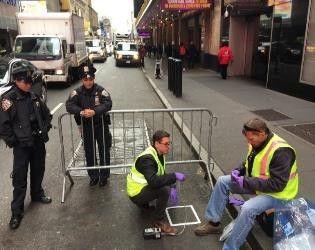Sampling operations following biological incidents
Partners: New York City (NYC) Department of Health and Mental Hygiene (DOHMH) and NYC Transit
Challenge: The ability to effectively identify and map contaminated areas following a large biological incident within a highly urbanized area in the U.S. (ongoing)
Resource: Technical assistance to evaluate the compatibility of current surface sampling options and analytical methods for Bacillus anthracis in an urban environment
“The instant that a biological threat agent incident has been detected, incident commanders will depend on and expect accurate and reliable incident characterization to support informed public health decision making. EPA’s groundbreaking efforts in this regard will prove critical to New York City’s ability to determine the scale and scope of biological incidents rapidly and efficiently.” – NYC DOHMH Bioterrorism Surveillance Coordinator Joel Ackelsberg, MD, MPH
EPA researchers have worked collaboratively with NYC DOHMH and NYC Transit to answer key gaps in capabilities to conduct effective sampling operations following a large biological incident within a highly urbanized area. EPA researchers, in collaboration with these partners, evaluated the compatibility of current surface sampling options, when applied to urbanized outdoor or underground (subway) surfaces, with current analytical methods for Bacillus anthracis. EPA researchers and NYC DOHMHC have also worked collaboratively to determine the potential utility of “Native Air Sampling” approaches, and their compatibility with analysis methods.
Because of this federal-local partnership, NYC personnel actively participate in project update teleconference meetings and provide critical input into the project’s directions. In this way, NYC has access to research outcomes as they develop, and NYC has ensured that the project meets the city’s emergency response needs. Ultimately, the project has resulted in an enhanced ability to conduct sampling and analysis operations for a large urban area following a Bacillus anthracis contamination incident.
